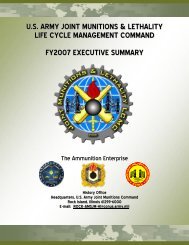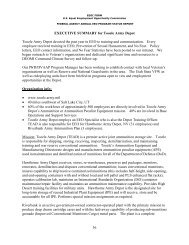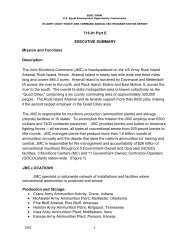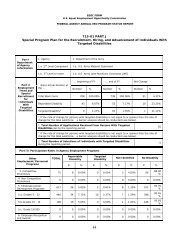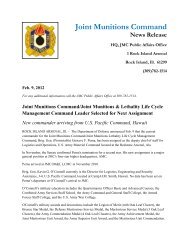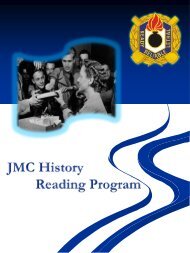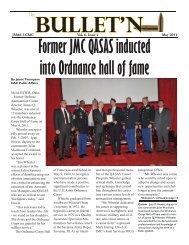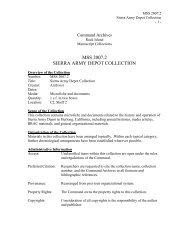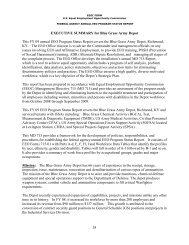History of the Ammunition Industrial Base - JMC - U.S. Army
History of the Ammunition Industrial Base - JMC - U.S. Army
History of the Ammunition Industrial Base - JMC - U.S. Army
You also want an ePaper? Increase the reach of your titles
YUMPU automatically turns print PDFs into web optimized ePapers that Google loves.
Date<br />
Rounds<br />
30 Nov 1917 156M<br />
31 Jan 1918 574M<br />
30 Apr 1918 1.3B<br />
31 July 1918 2.3B<br />
30 Sept 1918 2.9B<br />
31 Oct 1918 3.2B<br />
31 Dec 1918 3.94B<br />
Grenade production during WWI prompted one <strong>of</strong> <strong>the</strong> greatest challenges for <strong>the</strong><br />
industry. Initial requirements were set at 68 million live rounds and 3 million training rounds.<br />
After initial production and fielding, U.S. Soldiers refused to use defensive grenades because <strong>the</strong><br />
firing mechanisms were too complicated to use rapidly and Soldiers forgot to release <strong>the</strong> safety<br />
device which <strong>the</strong>n gave <strong>the</strong> Germans an opportunity to launch <strong>the</strong> rounds back at <strong>the</strong>m.<br />
Production was stopped and all items were reworked to new design specifications. Requirements<br />
were adjusted to 44 million rounds to be produced by eight industrial firms. Producers reached<br />
21 million rounds when <strong>the</strong> Armistice was signed. 82<br />
After 1918 most <strong>of</strong> <strong>the</strong> WWI statistical data and technical knowledge <strong>of</strong> requirements<br />
gained during <strong>the</strong> war were lost through disuse and failure to study <strong>the</strong> records before<br />
destruction. This, combined with a lack <strong>of</strong> technical requirement specialists in <strong>the</strong> workforce,<br />
caused <strong>the</strong> Ordnance Department to miss <strong>the</strong> opportunity to build and shape requirement<br />
calculations during peacetime before WWII mobilization. It wasn‟t until 1938, that <strong>the</strong><br />
“Partridge Report” by LTC Clarence E. Partridge and a board <strong>of</strong> Ordnance <strong>of</strong>ficers reported that<br />
after analysis <strong>of</strong> what little data was left over from WWI, “no current battle experience was<br />
available,” to base WWII requirements. 83 Historian, James Huston, noted <strong>the</strong> U.S. "had revealed<br />
<strong>the</strong> greatest war-making capacity that <strong>the</strong> world had ever seen,” 84 during WWI. At <strong>the</strong> war's end<br />
<strong>the</strong> United States had an <strong>Army</strong> <strong>of</strong> over 3.5 million and huge ordnance surpluses.<br />
WWII<br />
The U.S entered World War II (WWII) with virtually a non-existent munitions<br />
production base. WWI producers had returned to commercial production and <strong>the</strong> <strong>Army</strong> had to<br />
build a government owned base from scratch. Ordnance leaders describe <strong>the</strong> time period as<br />
“extremely” difficult as <strong>the</strong>y determined production base capacity while WWII ordnance<br />
requirements were in constant fluctuation. 85 Since ordnance requirements were established from<br />
troop basis figures which rose and fell every few months as <strong>the</strong> strategic situation changed,<br />
planning and implementing <strong>the</strong> industrial base size and capacity was a complex task throughout<br />
WWII. As soon as one computation <strong>of</strong> requirements was established it was necessary to<br />
incorporate changes and to recalculate computations. A war production board <strong>of</strong>ficial wrote, “It<br />
82 Ibid, 205-206.<br />
83 Thomson & Mayo, 49.<br />
84 “Center <strong>of</strong> Military <strong>History</strong>. Mobilization. Accessed at http://www.history.army.mil/documents/mobpam.htm,<br />
Section 4.<br />
85 Major N.A. Hamilton, <strong>Army</strong> Service Force, Office Chief <strong>of</strong> Ordnance, <strong>History</strong> <strong>of</strong> <strong>the</strong> Powder and Explosives<br />
Section (Washington, D.C., October 1945) Appendix II, 5.<br />
29



